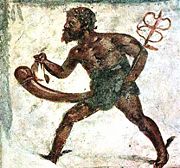History of erotic depictions
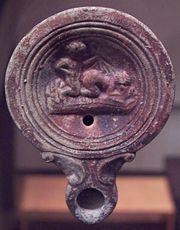
The history of erotic depictions includes paintings, sculpture, photographs, dramatic arts, music and writings that show scenes of a sexual nature throughout time. They have been created by nearly every civilisation, ancient and modern. Early cultures often associated the sexual act with supernatural forces and thus their religion is intertwined with such depictions. In Asian countries such as India, Nepal, Sri Lanka, Japan and China, representations of sex and erotic art have specific spiritual meanings within the native religions of Hinduism, Buddhism, Shinto and Taoism. The Greeks and Romans produced much art and decoration of an erotic nature, much of it integrated with their religious beliefs and cultural practices.[1][2]
In more recent times, erotic depictions have gone from being a luxury item for the few to a propaganda tool and then an everyday commodity, and even a livelihood for some. As the technology of communication has changed, each new technique, such as printing, photography, motion pictures and computers, has been adapted to display and disseminate these depictions.[3]
Contents |
Attitudes through history
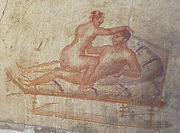
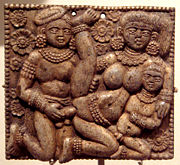
In early times, erotic depictions were often a subset of the indigenous or religious art of cultures and as such were not set aside or treated differently than any other type. The modern concept of pornography did not exist until the Victorian era. Its current definition was added in the 1860s, replacing the older one meaning writings about prostitutes.[4] It first appeared in an English medical dictionary in 1857 defined as "a description of prostitutes or of prostitution, as a matter of public hygiene."[5] By 1864, the first version of the modern definition had appeared in Webster's Dictionary: "licentious painting employed to decorate the walls of rooms sacred to bacchanalian orgies, examples of which exist in Pompeii."[6] This was the beginning of what today refers to explicit pictures in general. Though some specific sex acts were regulated or prohibited by earlier laws, merely looking at objects or images depicting them was not outlawed in any country until 1857. In some cases, the possession of certain books, engravings or image collections was outlawed, but the trend to compose laws that actually restricted viewing sexually explicit things in general was a Victorian construct.[3]
When large-scale excavations of Pompeii were undertaken in the 1860s, much of the erotic art of the Romans came to light, shocking the Victorians who saw themselves as the intellectual heirs of the Roman Empire. They did not know what to do with the frank depictions of sexuality, and endeavored to hide them away from everyone but upper class scholars. The movable objects were locked away in the Secret Museum in Naples, and what could not be removed was covered and cordoned off so as to not corrupt the sensibilities of women, children and the working class. England's (and the world's) first laws criminalising pornography were enacted with the passage of the Obscene Publications Act of 1857.[3] Despite their occasional repression, depictions of erotic themes have been common for millennia.[7]
Early depictions
-
For more details on this topic, see Art in ancient Greece, Erotic art in Pompeii and Herculaneum, Kama Sutra, and Pornography in Japan: History.


Among the oldest surviving examples of erotic depictions are Paleolithic cave paintings and carvings. Some of the more common images are of animals, hunting scenes and depictions of human genitalia (thought to be fertility symbols). Nude human beings with exaggerated sexual characteristics are depicted in some Paleolithic paintings and artifacts (e.g. Venus figurines). Recently discovered cave art at Creswell Crags in England, thought to be more than 12,000 years old, includes some symbols that may be stylized versions of female genitalia. However there is no indication that these were made for erotic stimulation, so it is far more likely that these were objects used in religious rituals.[8] Archaeologists in Germany reported in April 2005 that they had found what they believe is a 7,200-year-old scene depicting a male figurine bending over a female figurine in a manner suggestive of sexual intercourse. The male figure has been named Adonis von Zschernitz.[9] However, it is not certain that the purpose of these artifacts was individual sexual arousal. Instead, the images may have had a spiritual significance and are probably connected with fertility rituals.
The ancient Greeks often painted sexual scenes on their ceramics, many of them famous for being some of the earliest depictions of same-sex relations and pederasty. Greek art often portrays sexual activity, but it is impossible to distinguish between what to them was illegal or immoral since the ancient Greeks did not have a concept of pornography. Their art simply reflects scenes from daily life, some more sexual than others. Carved phalli can be seen in places of worship such as the temple of Dionysus on Delos, while a common household item and protective charm was the herm, a statue consisting of a head on a square plinth with a prominent phallus on the front. The Greek male ideal had a small penis, an aesthetic the Romans later adopted.[3][10][11] The Greeks also created the first well-known instance of lesbian eroticism in the West, with Sappho's Hymn to Aphrodite and other homoerotic works.[12]
There are numerous sexually explicit paintings and sculpture from the ruined Roman buildings in Pompeii and Herculaneum but the original purposes of the depictions can vary. On one hand, in the "Villa of the Mysteries", there is a ritual flagellation scene that is clearly associated with a religious cult and this image can be seen as having religious significance rather than sexual. On the other hand, graphic paintings in a brothel advertise sexual services in murals above each door. In Pompeii, phalli and testicles engraved in the sidewalks were created to aid visitors in finding their way by pointing to the prostitution and entertainment district as well as general decoration. The Romans considered depictions of sex to be decoration in good taste, and indeed the pictures reflect the sexual mores and practices of their culture, as on the Warren Cup. Sex acts that were considered taboo (such as those that defiled the purity of the mouth) were depicted in baths for comic effect. Large phalli were often used near entryways, for the phallus was a good luck charm, and the carvings were common in homes. One of the first objects excavated when the complex was discovered was a marble statue showing the god Pan having sex with a goat, a detailed depiction of bestiality considered so obscene that it was not on public display until the year 2000 and remains in the Secret Museum, Naples.[2][3][13]
The Moche of Peru are another ancient people that sculpted explicit scenes of sex into their pottery. Their purpose however, was much different than that of other early cultures. The Moche believed that the world of the dead was the exact opposite of the world of the living. Therefore, for funeral offerings, they made vessels showing sex acts such as masturbation, fellatio and anal sex that would not result in offspring. The hope was that in the world of the dead, they would take on their opposite meaning and result in fertility.


There has been a long tradition of erotic painting in the East. Japan, China, India, Persia and other lands produced copious quantities of art celebrating the human faculty of love. The works depict love between men and women as well as same-sex love. One of the most famous ancient sex manuals was the Kama Sutra, written by Vātsyāyana in India during the first few centuries CE.
In Japan, the erotic art found its greatest flowering in the medium of the woodblock prints. The style is known as shunga (春画 spring pictures?) and some of its classic practitioners (e.g. Harunobu, Utamaro) produced a large number of works. Painted hand scrolls were also very popular. Shunga appeared in the 13th century and continued to grow in popularity despite occasional attempts to suppress them, the first of which was a ban on erotic books known as kōshokubon ( 好色本?) issued by the Tokugawa shogunate in Kyōhō 7 (1722). Shunga only ceased to be produced in the 19th century when photography was invented.[1][14]
The Chinese tradition of the erotic was also extensive, with examples of the art dating back as far as the Yuan Dynasty (1271–1368). The erotic art of China reached its peak during the latter part of the Ming Dynasty (1368–1644).[1][15]
In both China and Japan, eroticism played a prominent role in the development of the novel. The Tale of Genji, the work by an 11th-century Japanese noblewoman that is often called “the world’s first novel,” traces the many affairs of its hero in discreet but carnal language.[16] From 16th-century China, the still more explicit novel The Plum in the Golden Vase has been called one of the four great classical novels of Chinese literature. The Tale of Genji has been celebrated in Japan since it was written, but The Plum in the Golden Vase was suppressed as pornography for much of its history, and replaced on the list of four classics.[17]
Erotic scenes in medieval illuminated manuscripts also appeared, but were seen only by those who could afford the extremely expensive hand made books. Most of these drawings occur in the margins of books of hours. Many medieval scholars think that the pictures satisfied the medieval cravings for both erotic pictures and religion in one book, especially since it was often the only book someone owned. Other scholars think the drawings in the margins were a kind of moral caution, but the depiction of priests and other ranking officials engaged in sex acts suggests political origins as well.[3]
It was not until the invention of the printing press by Johannes Gutenberg that sexually explicit images entered into any type of mass circulation in the western world. Before that time, erotic images, being hand made and expensive, were limited to upper class males who deliberately kept them away from the labouring class, fearing the effect such things would have on the animal lust of the uneducated. Even the British Museum had a Secretum filled with a collection of ancient erotica donated by the upper class doctor, George Witt in 1865. The remains of the collection, including his scrapbooks, still reside in Cupboard 55, though the majority of it has recently been integrated with the museum's other collections.[18]
Beginnings of mass circulation
Printing
- See also: Erotic literature and I Modi
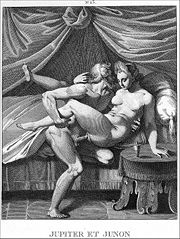
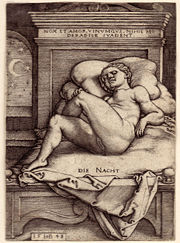
Prints became very popular in Europe from the middle of the fifteenth century, and because of their compact nature, were very suitable for erotic depictions that did not need to be permanently on display. Nudity and the revival of classical subjects were associated from very early on in history of the print, and many prints of subjects from mythological subjects were clearly in part an excuse for erotic material; the engravings of Giovanni Battista Palumba in particular. An earthier eroticism is seen in a printing plate of 1475-1500 for an Allegory of Copulation where a young couple are having sex, with the woman's legs high in the air, at one end of a bench, while at the other end a huge penis, with legs and wings and a bell tied around the bottom of the glans, is climbing onto the bench. Although the plate has been used until worn out, then re-engraved and heavily used again, none of the contemporary impressions printed, which probably ran into the hundreds, have survived.[19]
The loves of classical gods, especially those of Jupiter detailed in Ovid provided many subjects where actual sex was the key moment in the story, and its depiction was felt to be justified. In particular Leda and the Swan, where the god appeared as a swan and seduced the woman, was depicted very explicitly; it seems that this - rather strangely - was considered more acceptable because he appeared as a bird.[20] For a period ending in the early 16th century the boundaries of what could be depicted in for display in the semi-privacy of a Renaissance palace seemed uncertain. Michelangelo's Leda was a fairly large painting showing sex in progress, and one of the hundreds of illustrations to the book the Hypnerotomachia Poliphili of 1499 shows Leda and the Swan having sex on top of a triumphal car watched by a crowd.[21]
In the 16th century an attempt to print erotic material caused a scandal when the Italian Marcantonio Raimondi published I Modi in 1524, an illustrated book of 16 "postures" or sexual positions. Raimondi was subsequently imprisoned by the Pope Clement VII and all copies of the illustrations were destroyed. Raimondi based the engravings on a series of erotic paintings that Giulio Romano was doing as a commission for the Palazzo del Te in Mantua. Though the two depictions were very similar, only Raimondi was prosecuted because his engravings were capable of being seen by the public. Romano did not know of the engravings until Pietro Aretino came to see the original paintings while Romano was still working on them. Aretino then composed sixteen explicit sonnets ("both in your pussy and your behind, my cock will make me happy, and you happy and blissful")[3][22] to go with the paintings and secured Raimondi's release from prison. I Modi was then published a second time in 1527, with the poems and the pictures, making this the first time erotic text and images were combined, though the papacy once more seized all the copies it could find. Raimondi escaped prison that time, but the censorship was so complete that no complete editions of the original printings have ever been found. The text in existence is only a copy of a copy that was discovered 400 years later.[3][22]
In the 17th century, numerous examples of pornographic or erotic literature began to circulate. These included L'Ecole des Filles, a French work printed in 1655 that is considered to be the beginnings of pornography in France. It consists of an illustrated dialogue between two women, a 16-year-old and her more worldly cousin, and their explicit discussions about sex. The author remains anonymous to this day, though a few suspected authors served light prison sentences for supposed authorship of the work.[23] In his famous diary, Samuel Pepys records purchasing a copy for solitary reading and then burning it so that it would not be discovered by his wife; "the idle roguish book, L'escholle de filles; which I have bought in plain binding… because I resolve, as soon as I have read it, to burn it."[24]
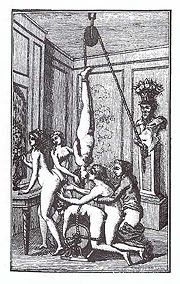
During the Enlightenment, many of the French free-thinkers began to exploit pornography as a medium of social criticism and satire. Libertine pornography was a subversive social commentary and often targeted the Catholic Church and general attitudes of sexual repression. The market for the mass-produced, inexpensive pamphlets soon became the bourgeoisie, making the upper class worry, as in England, that the morals of the lower class and weak-minded would be corrupted since women, slaves and the uneducated were seen as especially vulnerable during that time. The stories and illustrations (sold in the galleries of the Palais Royal, along with services of prostitutes) were often anti-clerical and full of misbehaving priests, monks and nuns, a tradition that in French pornography continued into the 20th century. In the period leading up to the French Revolution, pornography was also used as political commentary; Marie Antoinette was often targeted with fantasies involving orgies, lesbian activities and the paternity of her children, and rumors circulated about the supposed sexual inadequacies of Louis XVI.[23][25] During and after the Revolution, the famous works of the Marquis de Sade were printed. They were often accompanied by illustrations and served as political commentary for their author.[26]
The English answer to this was Memoirs of a Woman of Pleasure (later abridged and renamed Fanny Hill) written in 1748 by John Cleland. While the text satirised the literary conventions and fashionable manners of 18th century England, it was more scandalous for depicting a woman, the narrator, enjoying and even reveling in sexual acts with no dire moral or physical consequences. The text is hardly explicit as Cleland wrote the entire book using euphemisms for sex acts and body parts, employing 50 different ones just for the term penis. Two small earthquakes were credited to the book by the Bishop of London and Cleland was arrested and briefly imprisoned, but Fanny Hill continued to be published and is one of the most reprinted books in the English language. However, it was not legal to own this book in the United States until 1963 and in the United Kingdom until 1970.[27]
Photography
-
For more details on this topic, see History of erotic photography.
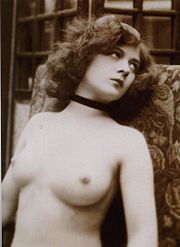
In 1839, Louis Daguerre presented the first practical process of photography to the French Academy of Sciences.[28] Unlike earlier photographic methods, his daguerreotypes had stunning quality and detail and did not fade with time. The new technology did not go unnoticed by artists eager for new ways to depict the undraped feminine form. Traditionally, an académie was a nude study done by a painter to master the female (or male) form. Each had to be registered with the French government and approved or they could not be sold. Soon, nude photographs were being registered as académie and marketed as aids to painters. However, the realism of a photograph as opposed to the idealism of a painting made many of these intrinsically erotic. [3]
The daguerreotypes were not without drawbacks, however. The main difficulty was that they could only be reproduced by photographing the original picture since each image was an original and the all metal process does not use negatives. In addition, the earliest daguerreotypes had exposure times ranging from three to fifteen minutes, making them somewhat impractical for portraiture. Unlike earlier drawings, action could not be shown. The poses that the models struck had to be held very still for a long time. Because of this, the standard pornographic image shifted from one of two or more people engaged in sex acts to a solitary woman exposing her genitals. Since one picture could cost a week's salary, the audience for these nudes mostly consisted of artists and the upper echelon of society. It was cheaper to hire a prostitute and experience the sex acts than it was to own a picture of them in the 1840s.[3] Stereoscopy was invented in 1838 and became extremely popular for daguerreotypes,[29][30] including the erotic images. This technology produced a type of three dimensional view that suited erotic images quite well. Although thousands of erotic daguerreotypes were created, only around 800 are known to survive; however, their uniqueness and expense meant that they were once the toys of rich men. Due to their rarity, the works can sell for more than 10,000 GBP.[3]
In 1841, William Fox Talbot patented the calotype process, the first negative-positive process, making possible multiple copies.[31] This invention permitted an almost limitless number of prints to be produced from a glass negative. Also, the reduction in exposure time made a true mass market for pornographic pictures possible. The technology was immediately employed to reproduce nude portraits. Paris soon became the centre of this trade. In 1848 only thirteen photography studios existed in Paris; by 1860, there were over 400. Most of them profited by selling illicit pornography to the masses who could now afford it. The pictures were also sold near train stations, by traveling salesmen and women in the streets who hid them under their dresses. They were often produced in sets (of four, eight or twelve), and exported internationally, mainly to England and the United States. Both the models and the photographers were commonly from the working class, and the artistic model excuse was increasingly hard to use. By 1855, no more photographic nudes were being registered as académie, and the business had gone underground to escape prosecution.[3]
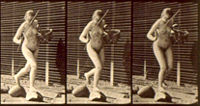
The Victorian pornographic tradition in Britain had three main elements: French photographs, erotic prints (sold in shops in Holywell Street, a long vanished London thoroughfare, swept away by the Aldwych), and printed literature. The ability to reproduce photographs in bulk assisted the rise of a new business individual, the porn dealer. Many of these dealers took advantage of the postal system to send out photographic cards in plain wrappings to their subscribers. Therefore, the development of a reliable international postal system facilitated the beginnings of the pornography trade. Victorian pornography had several defining characteristics. It reflected a very mechanistic view of the human anatomy and its functions. Science, the new obsession, was used to ostensibly study the human body. Consequently, the sexuality of the subject is often depersonalised, and is without any passion or tenderness. At this time, it also became popular to depict nude photographs of women of exotic ethnicities, under the umbrella of science. Studies of this type can be found in the work of Eadweard Muybridge. Although he photographed both men and women, the women were often given props like market baskets and fishing poles, making the images of women thinly disguised erotica.[3]
Magazines
-
For more details on this topic, see Pornographic magazine.
In 1880, halftone printing was used to reproduce photographs inexpensively for the first time.[28] The invention of halftone printing took pornography and erotica in new directions at the beginning of the 20th century. The new printing processes allowed photographic images to be reproduced easily in black and white, whereas printers were previously limited to engravings, woodcuts and line cuts for illustrations.[32] This was the first format that allowed pornography to become a mass market phenomena, it now being more affordable and more easily acquired than any previous form.[3]
First appearing in France, the new magazines featured nude (often, burlesque actresses were hired as models) and semi-nude photographs on the cover and throughout; while these would now be termed softcore, they were quite shocking for the time. The publications soon either masqueraded as "art magazines" or publications celebrating the new cult of naturism, with titles such as Photo Bits, Body in Art, Figure Photography, Nude Living and Modern Art for Men.[3] Health and Efficiency, started in 1900, was a typical naturist magazine in Britain.[33]
Another early form of pornography were comic books known as Tijuana bibles that began appearing in the U.S. in the 1920s and lasted until the publishing of glossy colour men's magazines commenced. These were crude hand drawn scenes often using popular characters from cartoons and culture.[34]
In the 1940s, the word "pinup" was coined to describe pictures torn from men's magazines and calendars and "pinned up" on the wall by U.S. soldiers in World War II. While the '40s images focused mostly on legs, by the '50s, the emphasis shifted to breasts. Betty Grable and Marilyn Monroe were two of the most popular pinup models. In the second half of the 20th century, pornography evolved into the men's magazines such as Playboy and Modern Man of the 1950s. In fact, the beginning of the modern men's glossy magazine (or girlie magazine) can be traced to the 1953 purchase by Hugh Hefner of a photograph of Marilyn Monroe to use as the centerfold of his new magazine Playboy. Soon, this type of magazine was the primary medium in which pornography was consumed.[35]
These magazines featured nude or semi-nude women, sometimes apparently masturbating, although their genitals or pubic hair were not actually displayed. Penthouse, started by Bob Guccione in England in 1965, took a different approach. Women looked indirectly at the camera, as if they were going about their private idylls. This change of emphasis was influential in erotic depictions of women. Penthouse was also the first magazine to publish pictures that included pubic hair and full frontal nudity, both of which were considered beyond the bounds of the erotic and in the realm of pornography at the time. In the late 1960s, magazines began to move into more explicit displays often focusing on the buttocks as standards of what could be legally depicted and what readers wanted to see changed. By the 1970s, they were focusing on the pubic area and eventually, by the 1990s, featured sexual penetration, lesbianism and homosexuality, group sex, masturbation, and fetishes in the more hard-core magazines such as Hustler.[3][35]
Magazines for every taste and fetish were soon created due to the low cost of producing them. Magazines for the gay community flourished, the most notable and one of the first being Physique Pictorial, started in 1951 by Bob Mizer when his attempt to sell the services of male models; however, Athletic Model Guild photographs of them failed. It was published in black and white, in a very clear yet photographic manner celebrating the male form and was published for nearly 50 years. The magazine was innovative in its use of props and costumes to depict the now standard gay icons like cowboys, gladiators and sailors.[3][36]
Moving pictures
-
For more details on this topic, see Pornographic film.

The next technological advance that affected the way people viewed erotic depictions was the invention of the motion picture. William Kennedy Dickson, while working for Thomas Edison, invented the first practical celluloid film and worked on making the kinetoscope, a peep show machine showing a continuous loop of the film Dickson invented lit by an Edison light source. Dickson left Edison's company to produce the mutoscope, a form of hand cranked peep show movie machine. These machines produced moving images by means of a revolving drum of card illustrations, taken from an actual piece of film. They were often featured at seaside locations, showing (usually) sequences of women undressing or acting as an artist's model. In Britain, they became known as "What the butler saw" machines, taking the name from one of the first and most famous softcore reels.[37][38]
The idea of projecting a moving film onto a screen in front of an audience was a European invention. In 1895 and 1896, Auguste and Louis Lumière and Robert W. Paul gave their first public demonstrations of motion picture projectors.[39]
Pornographic films were produced almost immediately after the medium was invented. Two of the earliest pioneers were Eugène Pirou and Albert Kirchner (Although today, Kirchner is chiefly remembered by film historians as the first man to produce a film about the life of Christ, the Passion du Christ), who directed the earliest surviving pornographic film for Pirou under the trade name "Léar". The 1896 film, Le Coucher de la Marie showed Mlle. Louise Willy performing a striptease. Pirou's film inspired a genre of risqué French films showing women disrobing when other filmmakers realised profits could be made.[40][41]
Because Pirou is nearly unknown as a pornographic filmmaker, credit is often given to other films for being the first. In Black and White and Blue (2008), one of the most scholarly attempts to document the origins of the clandestine 'stag film' trade, Dave Thompson recounts ample evidence that such an industry first had sprung up in the brothels of Buenos Aires and other South American cities by the turn of the century, and then quickly spread through Central Europe over the following few years; however none of these earliest pornographic films is known to survive. According to Patrick Robertson's Film Facts, "the earliest pornographic motion picture which can definitely be dated is A L'Ecu d'Or ou la bonne auberge" made in France in 1908; the plot depicts a weary soldier who has a tryst with a servant girl at an inn. The Argentinian El Satario might be even older; it has been dated to somewhere between 1907 and 1912. He also notes that "the oldest surviving pornographic films are contained in America's Kinsey Collection. One film demonstrates how early pornographic conventions were established. The German film Am Abend (1910) is "a ten-minute film which begins with a woman masturbating alone in her bedroom, and progresses to scenes of her with a man performing straight sex, fellatio and anal penetration."[42]
Soon illegal, stag films or blue films as they were called, were produced underground by amateurs for many years starting in the 1940s. Processing the film took considerable time and resources, with people using their bathtubs to wash the film when processing facilities (often tied to organized crime) were unavailable. The films were then circulated privately or by traveling salesman but being caught viewing or possessing them put one at the risk of prison.[3][43]
The post-war era saw developments that further stimulated the growth of a mass market. Technological developments, particularly the introduction of the 8mm and super-8 film gauges, resulted in the widespread use of amateur cinematography. Entrepreneurs emerged to supply this market. In Britain, the productions of Harrison Marks were "soft core", but considered risqué in the 1950s. On the continent, such films were more explicit. Lasse Braun was as a pioneer in quality colour productions that were, in the early days, distributed by making use of his father's diplomatic privileges. Pornography was legalized in the Netherlands in 1969 and this led to an explosion of commercially produced pornography. Now that being a pornographer was a legitimate occupation, there was no shortage of businessmen to invest in proper plant and equipment capable of turning out a mass-produced, cheap, but quality product. Vast amounts of this new pornography, both magazines and films, were smuggled into other parts of Europe, where it was sold "under the counter" or (sometimes) shown in "members only" cinema clubs.[3]
The first explicitly pornographic film with a plot that received a general theatrical release in the U.S. is generally considered to be Mona the Virgin Nymph (also known as Mona), a 59-minute 1970 feature by Bill Osco and Howard Ziehm, who went on to create the relatively high-budget hardcore/softcore (depending on the release) cult film Flesh Gordon.[44][43] The 1971 film Boys in the Sand represented a number of pornographic firsts. As the first generally available gay pornographic film, the film was the first to include on-screen credits for its cast and crew (albeit largely under pseudonyms), to parody the title of a mainstream film (in this case, The Boys in the Band), and to be reviewed by The New York Times.[45] In 1972, pornographic films hit their public peak in the United States with both Deep Throat and Behind the Green Door being met with public approval and becoming social phenomena. The Devil in Miss Jones followed in 1973 and many predicted that frank depictions of sex onscreen would soon become commonplace, but culture soon shifted to the more conservative side and that fantasy never came true. William Rotsler expressed this in 1973, "Erotic films are here to stay. Eventually they will simply merge into the mainstream of motion pictures and disappear as a labeled sub-division. Nothing can stop this."[46] In Britain however, Deep Throat was not approved in its uncut form until 2000 and not shown publicly until June of 2005.[43][47][48]
Video and digital depictions
-
For more details on this topic, see Internet pornography.

By 1982, most pornographic films were being shot on the cheaper and more convenient medium of videotape. Many film directors resisted this shift at first because of the different image quality that video tape produced, however those who did change soon were collecting most of the industry's profits since consumers overwhelmingly preferred the new format. The technology change happened quickly and completely when directors realised that continuing to shoot on film was no longer a profitable option. This change moved the films out of the theaters and into people's private homes. This was the end of the age of big budget productions and the mainstreaming of pornography. It soon went back to its earthy roots and expanded to cover every fetish possible since filming was now so inexpensive. Instead of hundreds of pornographic films being made each year, thousands now were, including compilations of just the sex scenes from various videos.[3][43]
Erotic CD-ROMs were popular in the late 1980s and early 1990s because they brought an unprecedented element of interactiveness and fantasy. However, their poor quality was a drawback and when the internet became common in households their sales declined. About the same time as the video revolution, the Internet became the preferred source of pornography for many people, offering both privacy in viewing and the chance to interact with people. The recent influx of widely available technology such as digital cameras, both moving and still, has blurred the lines between erotic films, photographs and amateur and professional productions. It allows easy access to both formats, making the production of them easily achieved by anyone with access to the equipment. Much of the pornography available today is produced by amateurs. Digital media is revolutionary in that it allows photographers and filmmakers to manipulate images in ways previously not possible, heightening the drama or eroticism of a depiction.[3]
High-definition video shows signs of changing the image of pornography as the technology is increasingly used for professional productions. The porn industry was one of the first to adopt the technology and it may have been a deciding factor in the format competition between HD DVD and Blu-ray Disc.[49] Additionally, the clearer sharper images it provides have prompted performers to get cosmetic surgery and professional grooming to hide imperfections that are not visible on other video formats. Other adaptations have been different camera angles and techniques for close-ups and lighting.[50]
References
- ↑ 1.0 1.1 1.2 Rawson, Phillip S. (1968). Erotic art of the east; the sexual theme in oriental painting and sculpture. New York: Putnam. pp. 380. LCC N7260.R35.
- ↑ 2.0 2.1 2.2 Clarke, John R. (April, 2003). Roman Sex: 100 B.C. to A.D. 250. New York: Harry N. Abrams. pp. 168. ISBN 0-8109-4263-1. http://www.amazon.com/Roman-Sex-100-B-C-D/dp/0810942631/ref=pd_bbs_2?ie=UTF8&s=books&qid=1202449141&sr=8-2.
- ↑ 3.00 3.01 3.02 3.03 3.04 3.05 3.06 3.07 3.08 3.09 3.10 3.11 3.12 3.13 3.14 3.15 3.16 3.17 3.18 3.19 3.20 3.21 Chris Rodley, Dev Varma, Kate Williams III (Directors) Marilyn Milgrom, Grant Romer, Rolf Borowczak, Bob Guccione, Dean Kuipers (Cast). (2006-03-07). Pornography: The Secret History of Civilization [DVD]. Port Washington, NY: Koch Vision. Retrieved on 2006-10-21. ISBN 1-4172-2885-7.
- ↑ Sigel, Lisa (2002). Governing Pleasures. Pornography and Social Change in England, 1815-1914. Rutgers University Press. ISBN 0-8135-3001-6.
- ↑ Dunglison, Robley (1857). Medical lexicon. A dictionary of medical science, 1857 edition, s.v. "Pornography". From the Oxford English Dictionary, second edition (1989), Oxford University Press, Retrieved on November 30, 2006.
- ↑ An American dictionary of the English language, new and revised edition (1864), s.v. "Pornography". From the Oxford English Dictionary, second edition (1989), Oxford University Press, Retrieved on November 30, 2006.
- ↑ Beck, Marianna (May, 2003). "The Roots of Western Pornography: Victorian Obsessions and Fin-de-Siècle Predilections". Libido, The Journal of Sex and Sensibility. Libido Inc. Retrieved on 2006-08-22.
- ↑ Pickrell, John (August 18 2004). "Unprecedented Ice Age Cave Art Discovered in U.K.". National Geographic News. Nationalgeographic.com. Retrieved on 2006-08-21.
- ↑ Driver, Krysia (2005-04-04). "Archaeologist finds 'oldest porn statue'". The Guardian. Guardian News and Media Limited. Retrieved on 2006-08-21.
- ↑ "Herm of Dionysos". The Getty Museum, J.Paul Getty Trust. Retrieved on 2006-10-19.
- ↑ Adams, Cecil (9 December 2005). "Why does so much ancient Greek art feature males with small genitalia?". The Straight Dope. Chicago Reader. Retrieved on 2006-10-19.
- ↑ Williamson, Margaret (1995). Sappho's Immortal Daughters. Cambridge, MA: Harvard University Press. ISBN 0-674-78912-1.
- ↑ Hemingway, Seán (Winter 2004). "Roman Erotic Art". Sculpture Review (National Sculpture Society) 53 (4): 10–15. http://www.sculpturereview.com/. Retrieved on 2006-10-24.
- ↑ Parent, Mary N, PhD (2001). "Shunga". Japanese Architecture and Art net users system. Retrieved on 2006-08-23.
- ↑ Bertholet, L.C.P. (October, 1997). Dreams of Spring: Erotic Art in China: From the Bertholet Collection. Pepin Press. ISBN 90-5496-039-6.
- ↑ Puette, William J. (2004). The Tale of Genji: A Reader’s Guide. Tuttle Publishing. ISBN 0-8048-3331-1.
- ↑ Roy, David Tod (1993). The Plum in the Golden Vase or, Chin P'ing Mei : The Gathering, Volume I. Princeton University Press. ISBN 0-691-06932-8.
- ↑ Giamster, David (September, 2000). "Sex and Sensibility at the British Museum". History Today (History Today) 50 (9): 10–15. http://www.historytoday.com/MainArticle.aspx?m=10989&amid=10989. Retrieved on 2006-10-16.
- ↑ Levinson, Jay A. (ed.); Konrad Oberhuber (1973). Early Italian Engravings from the National Gallery of Art. Washington, DC: National Gallery of Art. pp. pp.526–7. LOC 7379624.
- ↑ Bull, Malcolm (February 21, 2005). The Mirror of the Gods, How Renaissance Artists Rediscovered the Pagan Gods. USA: Oxford University Press. pp. p.167. ISBN 978-0-195-21923-4.
- ↑ Lefaivre, Liane (April 1, 2005). Leon Battista Alberti's 'Hypnerotomachia Poliphili':Re-Cognizing the Architectural Body in the Early Italian Renaissance. Cambridge, Massachusett: MIT Press. ISBN 978-0-262-62195-3. http://mitpress.mit.edu/catalog/item/default.asp?ttype=2&tid=10496.
- ↑ 22.0 22.1 Lawner, Lynne ed. (1989). I Modi: The Sixteen Pleasures: An Erotic Album of the Italian Renaissance. Northwestern University Press. ISBN 0-8101-0803-8.
- ↑ 23.0 23.1 Beck, Marianna (December, 2003). "The Roots of Western Pornography: The French Enlightenment Takes on Sex". Libido, The Journal of Sex and Sensibility. Libido Inc. Retrieved on 2006-08-22.
- ↑ Latham, Robert ed. (1985). The Shorter Pepys. University of California Press. ISBN 0-520-03426-0.
- ↑ Beck, Marianna (February, 2003). "The Roots of Western Pornography: The French Revolution and the Spread of Politically-Motivated Pornography". Libido, The Journal of Sex and Sensibility. Libido Inc. Retrieved on 2006-08-22.
- ↑ Beck, Marianna (March, 2003). "The Roots of Western Pornography: The Marquis de Sade's Twisted Parody of Life". Libido, The Journal of Sex and Sensibility. Libido Inc. Retrieved on 2006-08-22.
- ↑ Beck, Marianna (January, 2003). "The Roots of Western Pornography: England Bites Back With Fanny Hill". Libido, The Journal of Sex and Sensibility. Libido Inc. Retrieved on 2006-08-22.
- ↑ 28.0 28.1 Cross, J.M., PhD (2001-02-04). "Nineteenth-Century Photography: A Timeline". the Victorian Web. The University Scholars Programme, National University of Singapore. Retrieved on 2006-08-23.
- ↑ Wheatstone, Charles (June 21, 1838). "Contributions to the Physiology of Vision.—Part the First. On some remarkable, and hitherto unobserved, Phenomena of Binocular Vision.". Philosophical Transactions of the Royal Society of London (Royal Society of London) 128: 371–394. doi:. http://www.stereoscopy.com/library/wheatstone-paper1838.html. Retrieved on 2008-02-13.
- ↑ Klein, Alexander. "Sir Charles Wheatstone". Stereoscopy.com. Retrieved on 2006-08-23.
- ↑ Schaaf, Larry (1999). "The Calotype Process". Glasgow University Library. Retrieved on 2006-08-23.
- ↑ St. John, Kristen; Linda Zimmerman (June, 1997). "Guided Tour of Print Processes: Black and White Reproduction". Stanford library. Retrieved on 2006-08-24.
- ↑ "About H&E Naturist". Health and Efficiency Naturist. Retrieved on 2006-10-10.
- ↑ Adelman, Bob; Richard Merkin (September 1, 1997). Tijuana Bibles: Art and Wit in America's Forbidden Funnies, 1930s-1950s. New York: Simon & Schuster. pp. 160. ISBN 0-684-83461-8.
- ↑ 35.0 35.1 Gabor, Mark (February 27 1984). The Illustrated History of Girlie Magazines. New York: Random House Value Publishing. ISBN 0-517-54997-2.
- ↑ Bianco, David. "Physique Magazines". Planet Out History. PlanetOut Inc. Retrieved on 2006-10-10.
- ↑ "History". American Mutoscope & Biograph Co. (2006). Retrieved on 2006-10-16.
- ↑ "Let's Go to the Movies: The Mechanics of Moving Images". Exhibit Archives. Museum of American Heritage (17 September 2001). Retrieved on 2006-10-16.
- ↑ "Pioneers of Early Cinema: 5" (PDF). Information Sheet 5.3.43. National Museum of Photography, Film and Television (2000). Retrieved on 2006-10-16.
- ↑ Bottomore, Stephen; Stephen Herbert and Luke McKernan eds. (1996). "Léar (Albert Kirchner)". Who's Who of Victorian Cinema. British Film Institute. Retrieved on 2006-10-15.
- ↑ Bottomore, Stephen; Stephen Herbert and Luke McKernan eds. (1996). "Eugène Pirou". Who's Who of Victorian Cinema. British Film Institute. Retrieved on 2006-10-15.
- ↑ Robertson, Patrick (December, 2001). Film Facts. Billboard Books. pp. 256. ISBN 0-8230-7943-0.
- ↑ 43.0 43.1 43.2 43.3 Corliss, Richard (March 29, 2005). "That Old Feeling: When Porno Was Chic". Time Magazine. Time inc. Retrieved on 2006-10-16.
- ↑ Mehendale, Rachel (February 9, 2006). "Is porn a problem?" (PDF), Sex, The Daily Texan, pp. 17, 22. Retrieved on 2006-10-15.
- ↑ Edmonson, Roger; Cal Culver, Casey Donovan (October, 1998). Boy in the Sand: Casey Donovan, All-American Sex Star. Alyson Books. pp. 264. ISBN 1-55583-457-4.
- ↑ Schaefer, Eric (Fall 2005). "Dirty Little Secrets: Scholars, Archivists, and Dirty Movies". The Moving Image (University of Minnesota Press) 5 (2): 79–105. doi:.
- ↑ Hattenstone, Simon (June 11, 2005). "After 33 years, Deep Throat, the film that shocked the US, gets its first British showing", The Guardian, Guardian News and Media Limited. Retrieved on 2006-10-18.
- ↑ "Porn film on 'landmark 100' list", BBC News, BBC (October 5, 2006). Retrieved on 2006-10-28.
- ↑ Nystedt, Dan; Martyn Williams (July 30, 2007). "Japanese Porn Industry Embraces Blu-Ray Disc", PC World, PC World Communications, Inc.. Retrieved on 2007-10-15.
- ↑ Richtel, Matt (January 22, 2007). "In Raw World of Sex Movies, High Definition Could Be a View Too Real", The New York Times, The New York Times. Retrieved on 2007-10-15.
External links
|
|||||||||||||||||||||||||||||
